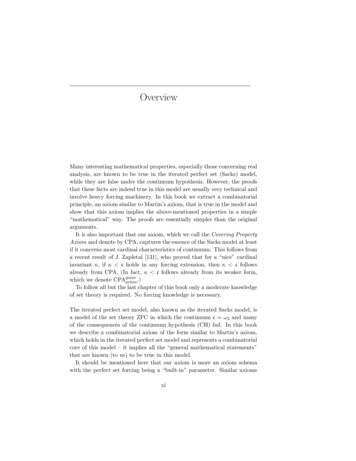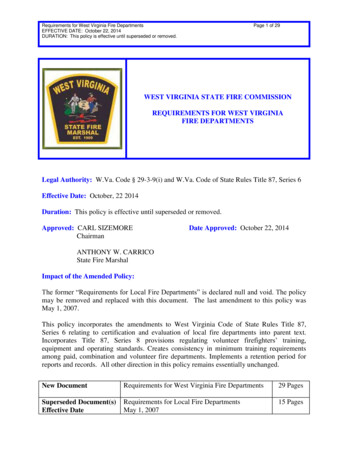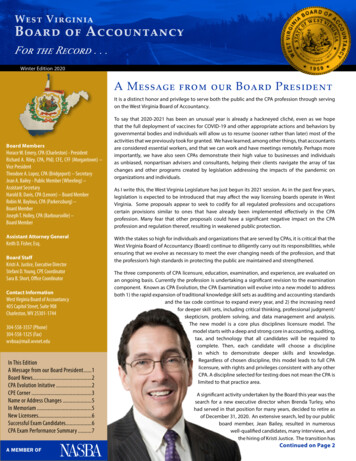
Transcription
OverviewMany interesting mathematical properties, especially those concerning realanalysis, are known to be true in the iterated perfect set (Sacks) model,while they are false under the continuum hypothesis. However, the proofsthat these facts are indeed true in this model are usually very technical andinvolve heavy forcing machinery. In this book we extract a combinatorialprinciple, an axiom similar to Martin’s axiom, that is true in the model andshow that this axiom implies the above-mentioned properties in a simple“mathematical” way. The proofs are essentially simpler than the originalarguments.It is also important that our axiom, which we call the Covering PropertyAxiom and denote by CPA, captures the essence of the Sacks model at leastif it concerns most cardinal characteristics of continuum. This follows froma recent result of J. Zapletal [131], who proved that for a “nice” cardinalinvariant κ, if κ c holds in any forcing extension, then κ c followsalready from CPA. (In fact, κ c follows already from its weaker form,which we denote CPAgameprism .)To follow all but the last chapter of this book only a moderate knowledgeof set theory is required. No forcing knowledge is necessary.The iterated perfect set model, also known as the iterated Sacks model, isa model of the set theory ZFC in which the continuum c ω2 and manyof the consequences of the continuum hypothesis (CH) fail. In this bookwe describe a combinatorial axiom of the form similar to Martin’s axiom,which holds in the iterated perfect set model and represents a combinatorialcore of this model – it implies all the “general mathematical statements”that are known (to us) to be true in this model.It should be mentioned here that our axiom is more an axiom schemawith the perfect set forcing being a “built-in” parameter. Similar axiomsxi
xiiOverviewalso hold for several other forcings (like iterated Miller and iterated Laverforcings; see, e.g., [131, sec. 5.1]). In this book, however, we concentrateonly on the axiom associated with the iterated perfect set model. This isdictated by two reasons: The axiom has the simplest form in this particular model, and the iterated perfect set model is the most studied from theclass of forcing models we are interested in — we have a good supply ofstatements against which we can test the power of our axiom. In particular, we use for this purpose the statements listed below as (A)–(H). Thecitations in the parentheses refer to the proofs that a given property holdsin the iterated perfect set model. For the definitions see the end of thenext section.(A) For every subset S of R of cardinality c there exists a (uniformly) continuous function f : R [0, 1] such that f [S] [0, 1]. (A. Miller [95])(B) Every perfectly meager set S R has cardinality less than c. (A. Miller[95])(C) Every universally null set S R has cardinality less than c. (R. Laver[84])(D) The cofinality of the ideal N of null (i.e., Lebesgue measure zero) setsis less than c. (Folklore, see, e.g., [97] or [4, p. 339])(E) There exist selective ultrafilters on ω, and any such ultrafilter is generated by less than c many sets. (J. Baumgartner and R. Laver [7])(F) There is no Darboux Sierpiński-Zygmund function f : R R; that is,for every Darboux function f : R R there is a subset Y of R of cardinality c such that f Y is continuous. (M. Balcerzak, K. Ciesielski,and T. Natkaniec [2])(G) For every Darboux function g: R R there is a continuous nowhereconstant function f : R R such that f g is Darboux. (J. Steprāns[123])(H) The plane R2 can be covered by less than c many sets, each of whichis a graph of a differentiable function (allowing infinite derivatives) ofeither a horizontal or vertical axis. (J. Steprāns [124])The counterexamples under CH for (B) and (C) are Luzin and Sierpińskisets. They have been constructed in [87]1 and [116], respectively. Thenegation of (A) is witnessed by either a Luzin or a Sierpiński set, as noticedin [116, 117]. The counterexamples under CH for (F) and (G) can be foundin [2] and [78], respectively. The fact that (D), (E), and (H) are false underCH is obvious.1Constructed also a year earlier by Mahlo [88].
OverviewxiiiThe book is organized as follows. Since our main axiom, which we callthe Covering Property Axiom and denote by CPA, requires some extradefinitions that are unnecessary for most of the applications, we will introduce the axiom in several approximations, from the easiest to state anduse to the most powerful but more complicated. All the versions of theaxiom will be formulated and discussed in the main body of the chapters.The sections that follow contain only the consequences of the axioms. Inparticular, most of the sections can be omitted in the first reading withoutcausing any difficulty in following the rest of the material.Thus, we start in Chapter 1 with a formulation of the simplest form ofour axiom, CPAcube , which is based on a natural notion of a cube in aPolish space. In Section 1.1 we show that CPAcube implies properties (A)–(C), while in Section 1.2 we present A. Nowik’s proof [107] that CPAcubeimplies that(I) Every uniformly completely Ramsey null S R has cardinality lessthan c.In Section 1.3 we prove that CPAcube implies property (D), that is,cof(N ) ω1 , and Section 1.4 is devoted to the proof that CPAcube impliesthe following fact, known as the total failure of Martin’s axiom:(J) c ω1 and for every nontrivial forcing P satisfying the countable chaincondition (ccc), there exists ω1 many dense sets in P such that no filterintersects all of them.Recall that a forcing P is ccc provided it has no uncountable antichains,where A P is an antichain in P provided no distinct elements of A havea common extension in P. The consistency of (J) was first proved byJ. Baumgartner [6] in a model obtained by adding Sacks reals side by side.In Section 1.5 we show that CPAcube implies that every selective ultrafilter is generated by ω1 sets (i.e., the second part of property (E)) andthat(K) r ω1 ,where r is the reaping (or refinement) number, that is,r min { W : W [ω]ω & A [ω]ω W W (W A or W ω \ A)}.In Section 1.6 we prove that CPAcube implies the following version of atheorem of S. Mazurkiewicz [91]:
xivOverview(L) For each Polish space X and for every uniformly bounded sequencefn : X R n ω of Borel measurable functions there are the sequences:Pξ : ξ ω1 of compact subsets of X and Wξ [ω]ω : ξ ω1 such that X ξ ω1 Pξ and for every ξ ω1 :fn Pξ n Wξ is a monotone uniformly convergent sequence of uniformly continuous functions.We also show that CPAcube “ selective ultrafilter on ω” implies the following variant of (L):(L ) Let X be an arbitrary set and let fn : X R be a sequence of functions such that the set {fn (x): n ω} is bounded for every x X.Then there are the sequences: Pξ : ξ ω1 of subsets of X and Wξ F: ξ ω1 such that X ξ ω1 Pξ and for every ξ ω1 :fn Pξn Wξis monotone and uniformly convergent.It should be noted here that a result essentially due to W. Sierpiński(see Example 1.6.2) implies that (L ) is false under Martin’s axiom.In Section 1.7 we present some consequences of cof(N ) ω1 that seemto be related to the iterated perfect set model. In particular, we prove thatcof(N ) ω1 implies that(M) c ω1 and there exists a Boolean algebra B of cardinality ω1 that isnot a union of a strictly increasing ω-sequence of subalgebras of B.The consistency of (M) was first proved by W. Just and P. Koszmider [72]in a model obtained by adding Sacks reals side by side, while S. Koppelberg [79] showed that Martin’s axiom contradicts (M).The last section of Chapter 1 consists of remarks on a form and consistency of CPAcube . In particular, we note that CPAcube is false in a modelobtained by adding Sacks reals side by side.In Chapter 2 we revise slightly the notion of a cube and introduce a cubegame GAMEcube — a covering game of length ω1 that is a foundation forour next (stronger) variant of the axiom, CPAgamecube . In Section 2.1, as itsapplication, we show that CPAgameimpliesthat:cube(N) c ω1 and for every Polish space there exists a partition of X into ω1disjoint closed nowhere dense measure zero sets.In Section 2.2 we show that CPAgamecube implies that:(O) c ω1 and there exists a family F [ω]ω of cardinality ω1 that issimultaneously maximal almost disjoint (MAD) and reaping.
OverviewxvSection 2.3 is devoted to the proof that, under CPAgamecube ,(P) there exists an uncountable γ-set.Chapter 3 begins with a definition of a prism, which is a generalizationof a notion of cube in a Polish space. This notion, perhaps the mostimportant notion of this text, is then used in our next generation of theaxioms, CPAgameprism and CPAprism , which are prism (stronger) counterpartsof axioms CPAgamecube and CPAcube . Since the notion of a prism is ratherunknown, in the first two sections of Chapter 3 we develop the tools thatwill help us to deal with them (Section 3.1) and prove for them the mainduality property that distinguishes them from cubes (Section 3.2). In theremaining sections of the chapter we discuss some applications of CPAprism .In particular, we prove that CPAprism implies the following generalizationof property (A):(A ) There exists a family G of uniformly continuous functions from R to[0, 1] such that G ω1 and for every S [R]c there exists a g Gwith g[S] [0, 1].We also show that CPAprism implies that:(Q) add(s0 ), the additivity of the Marczewski’s ideal s0 , is equal to ω1 c.In Section 3.4 we prove that:(N ) If G Gω1 , where Gω1 is the family of the intersections of ω1 manyopen subsets of a given Polish space X, and G c, then G containsa perfect set; however, there exists a G Gω1 that is not a union ofω1 many closed subsets of X.Thus, under CPAprism , Gω1 sets act to some extent as Polish spaces, butthey fall short of having property (N). The fact that the first part of (N )holds in the iterated perfect set model was originally proved by J. Brendle,P. Larson, and S. Todorcevic [12, thm. 5.10]. The second part of (N )refutes their conjecture [12, conj. 5.11]. We finish Chapter 3 with severalgameremarks on CPAgameprism . In particular, we prove that CPAprism implies axiomCPAgameprism (X ), in which the game is played simultaneously over ω1 Polishspaces.Chapters 4 and 5 deal with the applications of the axioms CPAprism andCPAgameprism , respectively. Chapter 4 contains a deep discussion of a problemof covering R2 and Borel functions from R to R by continuous functions ofdifferent smoothness levels. In particular, we show that CPAprism impliesthe following strengthening of property (H):
xviOverview(H ) There exists a family F of less than continuum many C 1 functionsfrom R to R (i.e., differentiable functions with continuous derivatives)such that R2 is covered by functions from F and their inverses.We also show the following covering property for the Borel functions:(R) For every Borel function f : R R there exists a family F of less thancontinuum many “C 1 ” functions (i.e., differentiable functions with continuous derivatives, where the derivative can be infinite) whose graphscover the graph of f .We also examine which functions can be covered by less than c many C nfunctions for n 1 and give examples showing that all of the coveringtheorems discussed are the best possible.Chapter 5 concentrates on several specific applications of CPAgameprism .Thus, in Section 5.1 we show that CPAgameimpliesthat:prism(S) There is a family H of ω1 pairwise disjoint perfect subsets of R such that H H is a Hamel basis, that is, a linear basis of R over Q.We also show that the following two properties are the consequences of (S):(T) There exists a nonmeasurable subset X of R without the Baire property that is N M-rigid, that is, such that X (r X) N M forevery r R.(U) There exists a function f : R R such that for every h R thedifference function h (x) f (x h) f (x) is Borel; however, forevery α ω1 there is an h R such that h is not of Borel class α.The implication CPAgameprism (T) answers a question related to the workof J. Cichoń, A. Jasiński, A. Kamburelis, and P. Szczepaniak [23]. Theimplication CPAgameprism (U) shows that a recent construction of such afunction from CH due to R. Filipów and I. RecTlaw [57] (and answering aquestion of M. Laczkovich from [82]) can also be repeated with the help ofour axiom. In Section 5.2 we show that CPAgameprism implies that:(V) There exists a discontinuous, almost continuous, and additive functionf : R R whose graph is of measure zero.The first construction of such a function, under Martin’s axiom, was givenby K. Ciesielski in [27]. It is unknown whether it can be constructed inZFC. We also prove there that, under CPAgameprism :(W) There exists a Hamel basis H such that E (H) has measure zero.
OverviewxviiHere E (A) is a linear combination of A R with nonnegative rationalcoefficients. This relates to the work of P. Erdős [54], H. Miller [98], andK. Muthuvel [100], who constructed such and similar Hamel bases underdifferent set theoretical assumptions. It is unknown whether (W) holds inZFC. In Section 5.3 we deduce from CPAgameprism that every selective ideal onω can be extended to a maximal selective ideal. In particular, the first partof condition (E) holds and u rσ ω1 , where u is the smallest cardinalityof the base for a nonprincipal ultrafilter on ω. In Section 5.4 we prove thatCPAgameprism implies that:(X) There exist many nonselective P -points as well as a family F [ω]ωof cardinality ω1 that is simultaneously independent and splitting.In particular, i ω1 , where i is the smallest cardinality of an infinitemaximal independent family. We finish the chapter with the proof thatCPAgameprism implies that:(Y) There exists a nonprincipal ultrafilter on Q that is crowded.In Chapter 6 we formulate the most general form of our axiom, CPA,and show that it implies all the other versions of the axiom. In Section 6.1we conclude from CPA that(Z) cov(s0 ) c.In Section 6.2 we show that CPA implies the following two generalizationsof property (F):(F ) For an arbitrary function h from a subset S of a Polish space X ontoa Polish space Y there exists a uniformly continuous function f froma subset of X into Y such that f h c.(F ) For any function h from a subset S of R onto a perfect subset of R there exists a function f “Cperf” such that f h c, and f can be extended to a function f “C 1 (R)” such that either f C 1 or f is an autohomeomorphism of R with f 1 C 1 .In Section 6.3 we show that (A)&(F ) (G). In particular, (G) followsfrom CPA.Finally, in Chapter 7 we show that CPA holds in the iterated perfect setmodel.
PreliminariesOur set theoretic terminology is standard and follows that of [4], [25], and[81]. The sets of real, rational, and integer numbers are denoted by R,Q, and Z, respectively. If a, b R and a b, then (b, a) (a, b) willstand for the open interval {x R: a x b}. Similarly, [b, a] [a, b]is an appropriate closed interval. The Cantor set 2ω will be denoted bythe symbol C. In this text we use the term Polish space for a completeseparable metric space without isolated points. A subset of a Polishspace is perfect if it is closed and contains no isolated points. For a Polishspace X, the symbol Perf(X) will denote the collection of all subsets of Xhomeomorphic to C; the closure of an A X will be denoted by cl(A);and, as usual, C(X) will stand for the family of all continuous functionsfrom X into R.A function f : R R is Darboux if a conclusion of the intermediate valuetheorem holds for f or, equivalently, when f maps every interval ontoan interval; f is a Sierpiński-Zygmund function if its restriction f Y isdiscontinuous for every subset Y of R of cardinality c; and f is nowhereconstant if it is not constant on any nontrivial interval.A set S R is perfectly meager if S P is meager in P for every perfectset P R, and S is universally null provided for every perfect set P Rthe set S P has measure zero with respect to every countably additiveprobability measure on P vanishing on singletons.For an ideal I on a set X, its cofinality is defined bycof(I) min{ B : B generates I}and its covering as cov(I) min B : B I &B X .The symbol N will stand for the ideal of Lebesgue measure zero subsetsxix
xxPreliminariesof R. For a fixed Polish space X. the ideal of its meager subsets will bedenoted by M, and we will use the symbol s0 (or s0 (X)) to denote theσ-ideal of Marczewski’s s0 -sets, that is,s0 {S X: ( P Perf(X))( Q Perf(X)) Q P \ S}.For an ideal I on a set X we use the symbol I to denote its coideal, thatis, I P(X) \ I.For an ideal I on ω containing all finite subsets of ω we use the followinggeneralized selectivity terminology. We say (see I. Farah [55]) that an idealI is selective provided for every sequence F0 F1 · · · of sets from I there exists an F I (called a diagonalization of this sequence) withthe property that F \ {0, . . . , n} Fn for all n F . Notice that thisdefinition agrees with the definition of selectivity given by S. Grigorieffin [65, p. 365]. (The ideals selective in the above sense Grigorieff callsinductive, but he also proves [65, cor. 1.15] that the inductive ideals andthe ideals selective in his sense are the same notions.)For A, B ω we write A B when A \ B ω. A set D I isdense in I provided for every B I there exists an A D such thatA B, and the set D is open in I if B D provided there is an A Dsuch that B A. For D̄ Dn I : n ω we say that F I is a diagonalization of D̄ provided F \ {0, . . . , n} Dn for every n ω.Following I. Farah [55] we say that an ideal I on ω is semiselective providedfor every sequence D̄ Dn I : n ω of dense and open subsets of I the family of all diagonalizations of D̄ is dense in I .Following S. Grigorieff [65, p. 390] we say that I is weakly selective(or weak selective) provided for every A I and f : A ω there existsa B I such that f B is either one to one or constant. (I. Farah,in [55, sec. 2], terms such ideals as having the Q -property. Note also thatJ. Baumgartner and R. Laver, in [7], call such ideals selective, despite thefact that they claim to use Grigorieff’s terminology from [65].)We have the following implications between these notions (see I. Farah[55, sec. 2]):I is selective I is semiselective I is weakly selectiveAll these notions represent different generalizations of the properties of theideal [ω] ω . In particular, it is easy to see that [ω] ω is selective.We say that an ideal I on a countable set X is selective (weakly selective)provided it is such upon an identification of X with ω via an arbitrarybijection. A filter F on a countable set X is selective (semiselective, weaklyselective) provided the same property has its dual ideal I {X\F : F F}.
PreliminariesxxiIt is important to note that a maximal ideal (or an ultrafilter) is selectiveif and only if it is weakly selective. This follows, for example, directly fromthe definitions of these notions as in S. Grigorieff [65]. Recall also that theexistence of selective ultrafilters cannot be proved in ZFC. (K. Kunen [80]proved that there are no selective ultrafilters in the random real model.This also follows from the fact that every selective ultrafilter is a P -point,while S. Shelah proved that there are models with no P -points; see, e.g., [4,thm. 4.4.7].)Acknowledgments. Janusz Pawlikowski wishes to thank West VirginiaUniversity for its hospitality in the years 1998–2001, where most of theresults presented in this text were obtained. The authors also thank Dr.Elliott Pearl for proofreading this monograph.
1Axiom CPAcube and its consequences:properties (A)–(E)For a Polish space X we will consider Perf(X), the family of all subsetsof X homeomorphic to the Cantor set C, as ordered by inclusion. Thus, afamily E Perf(X) is dense in Perf(X) provided for every P Perf(X)there exists a Q E such that Q P .All different versions of our axiom will be more or less of the form:If E Perf(X) is appropriately dense in Perf(X), then some portion E0 ofE covers almost all of X in a sense that X \ E0 c.If the word “appropriately” in the above is ignored, then it implies thefollowing statement: Naı̈ve-CPA: If E is dense in Perf(X), then X \ E c.It is a very good candidate for our axiom in the sense that it implies allthe properties we are interested in. It has, however, one major flaw — it is false! This is the case since S X \ E for some dense set E in Perf(X)provided:For each P Perf(X) there is a Q Perf(X) such that Q P \ S. This means that the family G of all sets of the form X \ E, where E isdense in Perf(X), coincides with the σ-ideal s0 of Marczewski’s sets, sinceG is clearly hereditary. Thus we have s0 X \E: E is dense in Perf(X) .(1.1)However, it is well known (see, e.g., [96, thm. 5.10]) that there are s0 -setsof cardinality c. Thus, our Naı̈ve-CPA “axiom” cannot be consistent withZFC.In order to formulate the real axiom CPAcube , we need the followingterminology and notation. A subset C of a product Cη of the Cantor set is1
21 Axiom CPAcube and its consequences: properties (A)–(E) said to be a perfect cube if C n η Cn , where Cn Perf(C) for each n.For a fixed Polish space X let Fcube stand for the family of all continuousinjections from perfect cubes C Cω onto perfect subsets of X. Each suchinjection f is called a cube in X and is considered as a coordinate systemimposed on P range(f ).1 We will usually abuse this terminology andrefer to P itself as a cube (in X) and to f as a witness function for P . Afunction g Fcube is a subcube of f provided g f . In the above spiritwe call Q range(g) a subcube of a cube P . Thus, when we say that Q isa subcube of a cube P Perf(X) we mean that Q f [C], where f is awitness function for P and C dom(f ) Cω is a perfect cube. Here andin what follows, the symbol dom(f ) stands for the domain of f .We say that a family E Perf(X) is Fcube -dense (or cube-dense) inPerf(X) provided every cube P Perf(X) contains a subcube Q E.More formally, E Perf(X) is Fcube -dense provided f Fcube g Fcube (g f & range(g) E).(1.2)It is easy to see that the notion of Fcube -density is a generalization of thenotion of density as defined in the first paragraph of this chapter:If E is Fcube -dense in Perf(X), then E is dense in Perf(X).(1.3)On the other hand, the converse implication is not true, as shown by thefollowing simple example.Example 1.0.1 Let X C C and let E be the family of all P Perf(X)such that either all vertical sections Px {y C: x, y P } of P are countable, or all horizontal sections P y {x C: x, y P } of P are countable.Then E is dense in Perf(X), but it is not Fcube -dense in Perf(X).Proof. To see that E is dense in Perf(X), let R Perf(X). We need tofind a P R with P E. If all vertical sections of R are countable, thenP R E. Otherwise, there exists an x such that Rx is uncountable.Then there exists a perfect subset P of {x} Rx R and clearly P E.To see that E is not Fcube -dense in Perf(X), it is enough to notice thatP X C C considered as a cube, where the second coordinate isidentified with Cω\{0} , has no subcube in E. More formally, let h be ahomeomorphism from C onto Cω\{0} , let g: C C Cω C Cω\{0} begiven by g(x, y) x, h(y) , and let f g 1 : Cω C C be the coordinate1In a language of forcing, a coordinate function f is simply a nice name for an elementfrom X.
Axiom CPAcube and its consequences: properties (A)–(E)3function making C C range(f ) a cube. Then range(f ) does not containa subcube from E.With these notions in hand we are ready to formulate our axiom CPAcube .For a Polish space X letCPAcube [X]: c ω2 , and for every Fcube -dense family E Perf(X) there is an E0 E such that E0 ω1 and X \ E0 ω1 .ThenCPAcube : CPAcube [X] for every Polish space X.We will show in Remark 1.8.3 that both these versions of the axiom areequivalent, that is, that CPAcube [X] is equivalent to CPAcube [Y ] for arbitrary Polish spaces X and Y .The proof that CPAcube is consistent with ZFC (it holds in the iteratedperfect set model) will be presented in the next chapters. In the remainderof this chapter we will take a closer look at CPAcube and its consequences.It is also worth noticing that, in order to check that E is Fcube -dense,it is enough to consider in condition (1.2) only functions f defined on theentire space Cω , that is:Fact 1.0.2 E Perf(X) is Fcube -dense if and only if f Fcube , dom(f ) Cω , g Fcube (g f & range(g) E).(1.4)Proof. To see this, let Φ be the family of all bijections h hn n ω between perfect subcubes n ω Dn and n ω Cn of Cω such that each hnis a homeomorphism between Dn and Cn . Thenf h Fcube for every f Fcube and h Φ with range(h) dom(f ).Now take an arbitrary f : C X from Fcube and choose an h Φ mappingCω onto C. Then fˆ f h Fcube maps Cω into X, and, using (1.4), we canfind a ĝ Fcube such that ĝ fˆ and range(ĝ) E. Then g f h[dom(ĝ)]satisfies (1.2).Next, let us consider1 scube X\E: E is Fcube -dense in Perf(X)0(1.5) {S X: cube P Perf(X) subcube Q P \ S}.1The second equation follows immediately from the fact that if E is Fcube -dense andY X \ E, then Y X \ E for some F cube -dense E . To see this, for every x Xchoose Tx Perf(X) such that Tx {x} E and note that E E {Tx : x X \Y }is as desired.
41 Axiom CPAcube and its consequences: properties (A)–(E)It can be easily shown, in ZFC, that scubeforms a σ-ideal. However, we0will not use this fact in this text in that general form. This is the case,since we will usually assume that CPAcube holds while CPAcube implies thefollowing stronger fact.Proposition 1.0.3 If CPAcube holds, then scube [X] ω1 .0Proof. It is obvious that CPAcube implies scube [X] c . The other0inclusion is always true, and it follows from the following simple fact.Fact 1.0.4 [X] c scube s0 for every Polish space X.0Proof. Choose S [X] c . In order to see that S scube, note that0the family E {P Perf(X): P S } is Fcube -dense in Perf(X).Indeed, if function f : Cω X is from Fcube , then there is a perfect subsetP0 of C that is disjoint with the projectionπ0 (f 1 (S)) of f 1 (S) into Pi C for allthe first coordinate. Theni ω f Pi S , where 0 i ω. Therefore, fP. Since E.Thus,X\E scubei0i ω cubeclearly S X \ E, we get S s0 .The inclusion scube s0 follows immediately from (1.1), (1.5), and (1.3).01.1 Perfectly meager sets, universally null sets, and continuousimages of sets of cardinality continuumThe results presented in this section come from K. Ciesielski and J. Pawlikowski [39]. An important quality of the ideal scube, and so the power of0 cthe assumption scube [X],iswelldepictedbythefollowing fact.0Proposition 1.1.1 If X is a Polish space and S X does not belong toscube, then there exist a T [S]c and a uniformly continuous function h0from T onto C.Proof. Take an S as above and let f : Cω X be a continuous injectionsuch that f [C] S % for every perfect cube C. Let g: C C be acontinuous function such that g 1 (y) is perfect for every y C. Thenclearly h0 g π0 f 1 : f [Cω ] C is uniformly continuous. Moreover, ifT S f [Cω ], then h0 [T ] C since 1 1T h 1(y))] S f [g 1 (y) C C · · ·] % 0 (y) T f [π0 (gfor every y C.
1.1 Perfectly meager and universally null sets; continuous images5Corollary 1.1.2 Assume scube [X] c for a Polish space X. If S X has0cardinality c, then there is a uniformly continuous function f : X [0, 1]such that f [S] [0, 1]. In particular, CPAcube implies property (A).Proof. If S is as above, then, by CPAcube , S / scube. Thus, by Proposi0tion 1.1.1 there exists a uniformly continuous function h from a subset of Sonto C. Consider C as a subset of [0, 1] and let ĥ: X [0, 1] be a uniformlycontinuous extension of h. If g: [0, 1] [0, 1] is continuous and such thatg[C] [0, 1], then f g ĥ is as desired.For more on property (A) see also Corollary 3.3.5.It is worth noticing here that the function f in Corollary 1.1.2 cannot berequired to be either monotone or in the class “D1 ” of all functions havinga finite or infinite derivative at every point. This follows immediately fromthe following proposition, since each function that is either monotone or“D1 ” belongs to the Banach class(T2 ) f C(R): {y R: f 1 (y) ω} N .(See [58] or [114, p. 278].)Proposition 1.1.3 There is, in ZFC, an S [R]c such that [0, 1] % f [S]for every f (T2 ).Proof. Let {fξ : ξ c} be an enumeration of all functions from (T2 ) whoserange contains [0, 1]. Construct by induction a sequence sξ , yξ : ξ csuch that, for every ξ c,(i) yξ [0, 1] \ fξ [{sζ : ζ ξ}] and fξ 1 (yξ ) ω. (ii) sξ R \ {sζ : ζ ξ} ζ ξ fζ 1 (yζ ) .Then the set S {sξ : ξ c} is as required since yξ [0, 1] \ fξ [S] for everyξ c.Theorem 1.1.4 If S R is either perfectly meager or universally null,then S scube. In particular,0CPAcube “scube [R] c ” “(B) & (C).”0Proof. Take an S R that is either perfectly meager or universally nulland let f : Cω R be a continuous injection. Then S f [Cω ] is eithermeager or null in f [Cω ]. Thus G Cω \ f 1 (S) is either comeager or of fullmeasure in Cω . Hence the theorem follows immediately from the followingclaim, which will be used many times in the sequel.
61 Axiom CPAcube and its consequences: properties (A)–(E)Claim 1.1.5 Consider Cω with its usual topology and its usual productmeasure. If G is a Borel subset of Cω that is either of the second category or of positive measure, then G contains a perfect cube i ω Pi .In particular, if G is a countable cover
our axiom, CPA cube, which is based on a natural notion of a cube in a Polishspace. InSection1.1weshowthatCPA cubeimpliesproperties(A)- hatCPA cube impliesthat (I) Every uniformly completely Ramsey null S R has cardinality less thanc. In Section 1.3 we prove that CPA cube implies property .











